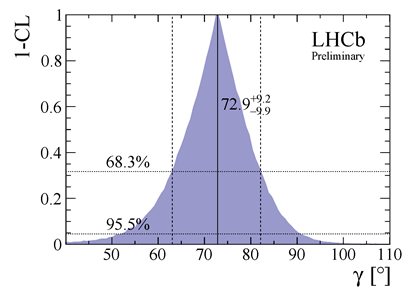Today at the International Workshop on the CKM Unitarity Triangle, CKM2014, Vienna, Austria, the LHCb collaboration has presented a combination of measurements of the CKM angle γ (in tree decays, see below). For the first time a single experiment has achieved a precision of better than 10 degrees, which is better than the combination of the results of the B-factory experiments, BaBar and Belle. The parameters that describe the difference in behaviour between matter and antimatter, known as CP violation, are constrained in the so called CKM, or unitarity, triangle. The angles of this triangle are denoted α, β and γ, and of these it is γ that is the least precisely known. A detailed introduction to the CKM angle γ measurement can be found in the 5 October 2012 news and in the CERN Courier article. The measurement of the angle γ in different processes is one of the most important goals of LHCb experiment. The idea is to measure precisely the angle γ in processes in which a contribution from new physics is possible and in processes in which it is not. Comparison between the results of these two categories of measurement is therefore a powerful method to probe for the effects of new physics.
The value of the angle γ = (72.9+9.2-9.9)° presented today was obtained using B(s)→D(s)K(*) decays in the analysis, in which B or Bs meson decays into D or Ds mesons were observed in the full 3 fb-1 2011 and 2012 data set. The image shows a confidence level (CL) curve that indicates which values of γ describe best the LHCb data. The 68.3% horizontal line shows how the γ angle uncertainty was determined. Signs of new physics are not expected to show up in these decays (the so called tree-level measurements, for experts) and therefore they will set a base for comparison with the measurements where observation of new physics effects is possible.
The LHCb result will be improved still further before the start of new data taking period in spring 2015 using the already available data, since there are still important analyses to be completed. In addition LHCb has a large set of γ-sensitive observables in B→Dπ decays not discussed in this news. However their sensitivity to γ is suppressed compared to the B→DK-like decays.
Read more in the LHCb presentation in Vienna, in the LHCb conference note and in the CERN Courier article.

